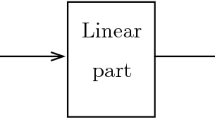Abstract
In this paper, modeling and identification of nonlinear dynamic systems using neuro-fractional Hammerstein model are considered. The proposed model consists of the neural networks (NNs) as the nonlinear subsystem and the fractional-order state space (FSS) as the linear subsystem. The identification procedure consists of a hybrid frequency-/time-domain approach based on the input–output data acquired from the system. First in the frequency domain, the fractional order and fractional degree of the FSS subsystem are determined offline using an iterative linear optimization algorithm. Then, in the time domain, the state-space matrices of the FSS as well as parameters of the NN are estimated using Lyapunov stability theory. Moreover, in order to use only the input–output data from the system, a fractional-order linear observer based on auxiliary model idea is utilized to estimate the system states. The convergence and stability analysis of the proposed method are provided. Simulating and experimental examples show superior performance of the proposed method as compared with the Hammerstein models reported in the literature.






Similar content being viewed by others
References
Aguila-Camacho N, Duarte-Mermoud MA, Gallegos JA (2014) Lyapunov functions for fractional order systems. Commun Nonlinear Sci Numer Simul 19:2951–2957. doi:10.1016/j.cnsns.2014.01.022
Aoun M, Maltl R, Cois O (2002) Oustaloup A System identification using fractional Hammerstein models. In: Proceedings of the 15th IFAC world congress
Benchellal A, Poinot T, Trigeassou JC (2006) Approximation and identification of diffusive interfaces by fractional models. Sig Process 86:2712–2727. doi:10.1016/j.sigpro.2006.02.025
Caponetto R, Graziani S, Sapuppo F, Tomasello V (2013) An enhanced fractional order model of ionic polymer-metal composites actuator. Adv Math Phys 2013:1–6. doi:10.1155/2013/717659
Chen H, Xiao Y, Ding F (2014) Hierarchical gradient parameter estimation algorithm for Hammerstein nonlinear systems using the key term separation principle. Appl Math Comput 247:1202–1210. doi:10.1016/j.amc.2014.09.070
Chen J (2014) Several gradient parameter estimation algorithms for dual-rate sampled systems. J Franklin Inst 351:543–554. doi:10.1016/j.jfranklin.2013.08.016
Chen S, Hong X, Gao J, Harris CJ (2014b) Complex-valued B-spline neural networks for modeling and inverting Hammerstein systems. IEEE Trans Neural Netw Learn Syst 25:1673–1685
Chen Y-C, Wang J-S (2009) A Hammerstein–Wiener recurrent neural network with frequency-domain eigensystem realization algorithm for unknown system identification. J UCS 15:2547–2565
Cui M, Liu H, Li Z, Tang Y, Guan X (2014) Identification of Hammerstein model using functional link artificial neural network. Neurocomputing 142:419–428. doi:10.1016/j.neucom.2014.03.051
De moor BLR (2015) Daisy: database for the identification of systems, department of electrical engineering (ed) ESAT/SISTA, KU Leuven, Belgium. url: \(\langle \) http://homes.Esat.Kuleuven.Be/smc/daisy \(\rangle \)
Ding F, Liu X, Chen H, Yao G (2014) Hierarchical gradient based and hierarchical least squares based iterative parameter identification for CARARMA systems. Sig Process 97:31–39. doi:10.1016/j.sigpro.2013.10.018
Ding F, Liu X, Chu J (2013) Gradient-based and least-squares-based iterative algorithms for Hammerstein systems using the hierarchical identification principle. IET Control Theory Appl 7:176–184. doi:10.1049/iet-cta.2012.0313
Ding F, Liu X, Ma X (2016) Kalman state filtering based least squares iterative parameter estimation for observer canonical state space systems using decomposition. J Comput Appl Math 301:135–143
Djamah T, Mansouri R, Bettayeb M (2009) Djennoune S State space realization of fractional order systems. In: 2nd Mediterranean conference on intelligent systems and automation (CISA’09) vol 1. AIP Publishing, pp 37–42
Dullerud G, Smith R (1996) Sampled-data model validation: an algorithm and experimental application. Int J Robust Nonlinear Control 6:1065–1078
Fu Z-J, Xie W-F, Luo W-D (2013) Robust on-line nonlinear systems identification using multilayer dynamic neural networks with two-time scales. Neurocomputing 113:16–26
Gabano JD, Poinot T (2011a) Estimation of thermal parameters using fractional modelling. Sig Process 91:938–948. doi:10.1016/j.sigpro.2010.09.013
Gabano JD, Poinot T (2011b) Fractional modelling and identification of thermal systems. Sig Process 91:531–541. doi:10.1016/j.sigpro.2010.02.005
Galvão RKH, Hadjiloucas S, Kienitz KH, Paiva HM, Afonso RJM (2013) Fractional order modeling of large three-dimensional RC networks. IEEE Trans Circuits Syst I Regul Pap 60:624–637
Garnier H, Young PC (2014) The advantages of directly identifying continuous-time transfer function models in practical applications. Int J Control 87:1319–1338
Guo Y, Wang Y, Sun G, Mao J (2012) Modeling of rate-dependent hysteresis for piezoelectric actuator with MPI model-based Hammerstein system. In: Intelligent robotics and applications. Springer, Berlin, pp 281-290
Hong X, Chen S, Harris CJ, Khalaf EF (2014) Single-carrier frequency-domain equalization for Hammerstein communication systems using complex-valued neural networks. IEEE Trans Signal Process 62:4467–4478. doi:10.1109/tsp.2014.2333555
Hu H, Ding R (2014) Least squares based iterative identification algorithms for input nonlinear controlled autoregressive systems based on the auxiliary model. Nonlinear Dyn 76:777–784
Hu P, Ding F, Sheng J (2013) Auxiliary model based least squares parameter estimation algorithm for feedback nonlinear systems using the hierarchical identification principle. J Franklin Inst 350:3248–3259. doi:10.1016/j.jfranklin.2013.07.013
Ibnkahla M (2012) Stochastic analysis of neural network modeling and identification of nonlinear memoryless MIMO systems. EURASIP J Adv Signal Process 2012:1–22
Jia L, Chiu M-S, Ge SS (2005) A noniterative neuro-fuzzy based identification method for Hammerstein processes. J Process Control 15:749–761. doi:10.1016/j.jprocont.2005.03.006
Li Y, Chen Y, Podlubny I (2009) Mittag-Leffler stability of fractional order nonlinear dynamic systems. Automatica 45:1965–1969
Liao Z, Zhu Z, Liang S, Peng C, Wang Y (2012) Subspace identification for fractional order Hammerstein systems based on instrumental variables. Int J Control Autom Syst 10:947–953. doi:10.1007/s12555-012-0511-5
Lorenzo PR, Nalepa J, Kawulok M, Ramos LS, Pastor JR (2017) Particle swarm optimization for hyper-parameter selection in deep neural networks. In: Proceedings of the genetic and evolutionary computation conference. ACM, pp 481–488
Mkadem F, Boumaiza S (2009) Extended Hammerstein behavioral model using artificial neural networks. IEEE Trans Microw Theory Tech 57:745–751
Pintelon R, Schoukens J (2012) System identification: a frequency-domain approach. Wiley, New York
Podlubny I (1999) Fractional differential equations : an introduction to fractional derivatives, to methods of their solution and some of their applications. Mathematics in Science and Engineering. Academic Press, New York
Ren X, Lv X (2011) Identification of extended Hammerstein systems using dynamic self-optimizing neural networks. IEEE Trans Neural Netw 22:1169–1179
Van Pelt TH, Bernstein DS (2010) Non-linear system identification using Hammerstein and non-linear feedback models with piecewise linear static maps. Int J Control 74:1807–1823. doi:10.1080/00207170110089798
Wang D, Ding F, Ximei L (2013) Least squares algorithm for an input nonlinear system with a dynamic subspace state space model. Nonlinear Dyn 75:49–61. doi:10.1007/s11071-013-1048-8
Wang X, Ding F (2015) Recursive parameter and state estimation for an input nonlinear state space system using the hierarchical identification principle. Sig Process 117:208–218
Yu F, Mao Z, Jia M (2013) Recursive identification for Hammerstein–Wiener systems with dead-zone input nonlinearity. J Process Control 23:1108–1115. doi:10.1016/j.jprocont.2013.06.014
Zhao J, Ma X, Zhao S, Fei J (2014a) Hammerstein identification of supercharged boiler superheated steam pressure using Laguerre-Fuzzy model. Int J Heat Mass Transf 70:33–39. doi:10.1016/j.ijheatmasstransfer.2013.10.056
Zhao Y, Li Y, Chen Y (2014b)Complete parametric identification of fractional order Hammerstein systems. In: 2014 International conference on fractional differentiation and its applications (ICFDA). IEEE. pp 1–6
Author information
Authors and Affiliations
Corresponding author
Ethics declarations
Conflict of interest
The authors declare that they have no conflict of interest.
Additional information
Communicated by V. Loia.
Rights and permissions
About this article
Cite this article
Rahmani, MR., Farrokhi, M. Identification of neuro-fractional Hammerstein systems: a hybrid frequency-/time-domain approach. Soft Comput 22, 8097–8106 (2018). https://doi.org/10.1007/s00500-017-2749-6
Published:
Issue Date:
DOI: https://doi.org/10.1007/s00500-017-2749-6




